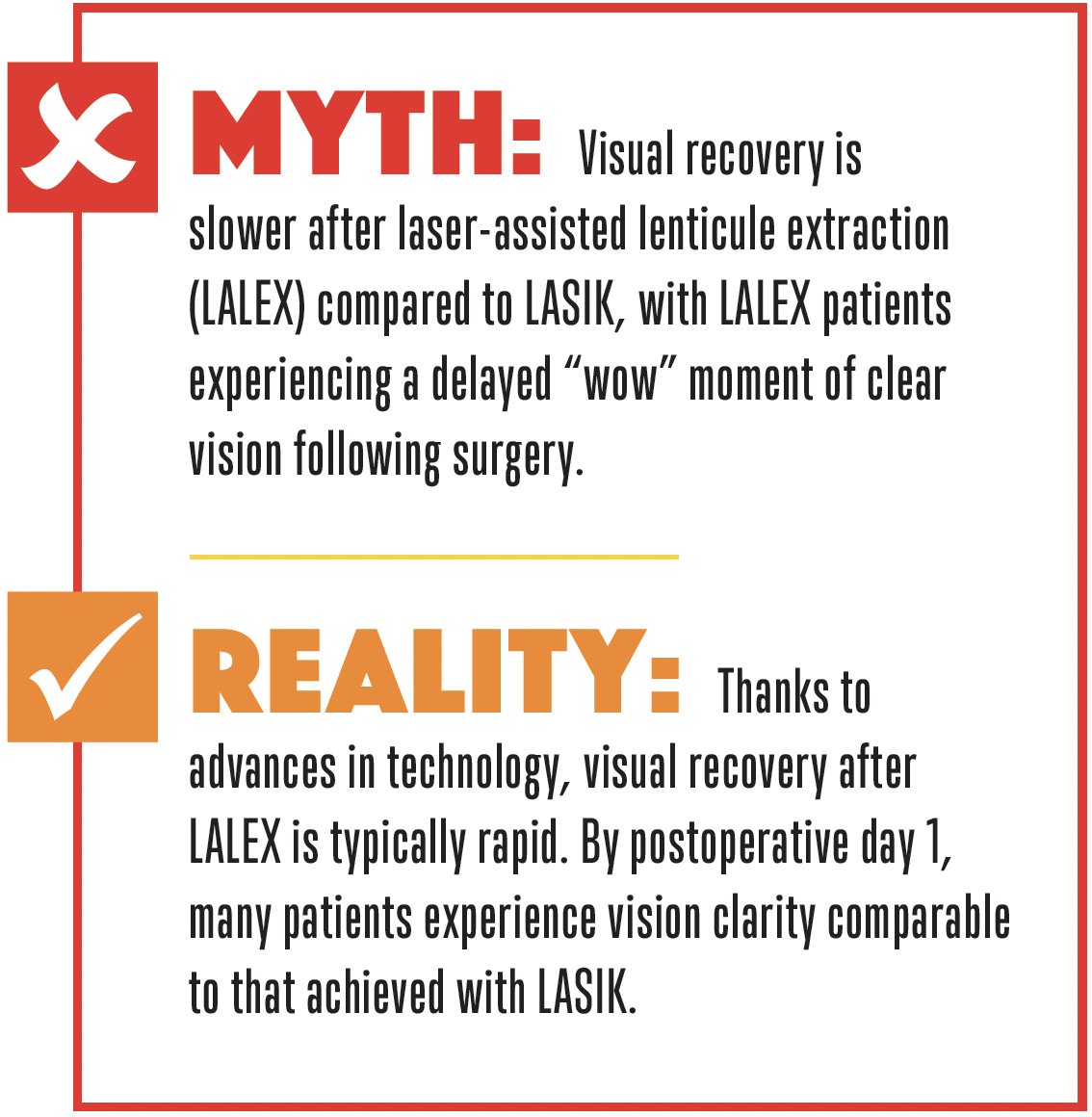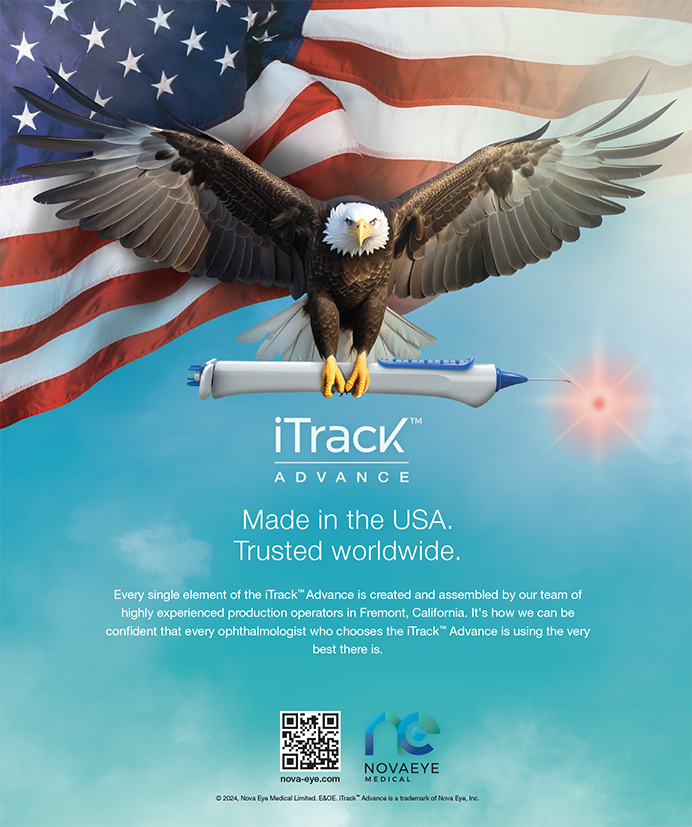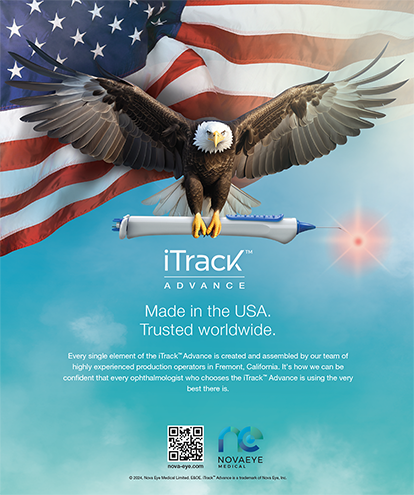
If there were ever a myth to be busted, it is that laser-assisted lenticule extraction (LALEX) has a delayed “wow” effect. This exercise is long overdue. I hope to distill 15 years of experience as a surgeon performing small-incision lenticule extraction (SMILE) with the VisuMax (Carl Zeiss Meditec) into an overview of what LALEX, particularly SMILE, delivers in late 2024.

THE HISTORY AND TERMINOLOGY OF LALEX AND SMILE
In appreciation of the keratospeak terminology originally coined by George O. Waring III, MD,1,2 the refractive community has long struggled to describe SMILE-like procedures in nonproprietary terms. Two terms have emerged that provide anatomic clarity and aptly describe lenticule extraction procedures while avoiding proprietary language: LALEX and keratorefractive lenticule extraction (KLEX). Because my experience is limited to the VisuMax system, however, this article focuses exclusively on SMILE. (Editors’ note: CRST uses the term LALEX to describe all procedures in this category.)
DEFINING THE ‘WOW’ EFFECT
When I talk about refractive surgery’s “wow” effect, I am primarily referring to patients’ excellent unaided vision immediately after the procedure. This is the cornerstone of patient satisfaction and is the primary focus of this discussion. It would be remiss, however, not to mention other variables that affect patient satisfaction on the day of surgery and in the early postoperative period (first few weeks and months). These include pain, tearing, light sensitivity, foreign body sensation, dryness, glare, halos, starbursts, and the ability to return to work or normal physical activities.
THE IMPORTANCE OF VISUAL RECOVERY
The return of vision—achieving super clear vision that is nearly equivalent to the patient’s preoperative BCVA—is critical. This is what surgeons aim to provide, and it is on this that patients base their judgment of the outcome on the day of and the day following surgery. As a former LASIK patient myself, I know firsthand that fully functional vision on the day of surgery and certainly by postoperative day 1 is part of the procedure’s magic.
In terms of rapid visual recovery, LASIK is often considered the gold standard. Patients’ vision is typically exceptional on the day after LASIK versus functional on the day after PRK. Certain aspects of patients’ quality of vision 1 day after receiving an EVO ICL (STAAR Surgical) can match or surpass that achieved 1 day after LASIK.
TECHNOLOGICAL ADVANCES
US FDA clinical trials of SMILE for spherical myopia began in 2012. My fellow investigators and I were allowed to treat one eye with SMILE and the other with LASIK. The studies were designed to assess the procedure’s safety and efficacy, not to compare it directly to LASIK. Nevertheless, I noted that 50% of 180 patients treated in two studies preferred the vision in their LASIK eye on postoperative day 1, 30% preferred the vision in their SMILE eye, and 20% liked the vision in both eyes equally. Among those who favored their LASIK eye, the UCVA in their SMILE eye usually ranged from 20/20 to 20/50 on day 1 but matched the UCVA in their LASIK eye within 2 weeks.
Since the commercial introduction of SMILE in the United States in 2017 and its approval for compound myopic astigmatism in 2018, the difference in visual recovery time after SMILE compared to LASIK has largely disappeared. With SMILE, postoperative visual recovery depends on two main factors: (1) the accuracy and precision of shot placement and (2) tissue response to the laser treatment.
The introduction of the VisuMax 800 with SMILE pro software (Carl Zeiss Meditec) optimized several key parameters. First, the spot separation can be adjusted from 3 to 4.5 µm. This flexibility allows a 30% reduction in the total energy delivered without sacrificing precision. Second, automated centration with CentraLign and automated astigmatic treatment registration with OcuLign have streamlined these processes. Third, separation distances for spot spacing (4 µm) and track spacing (3.5 µm) can be adjusted, changes that have resulted in the easiest dissections I have seen in 13 years of performing SMILE and my patients’ quickest postoperative visual recovery to date. The lowest energy setting available in the United States is 125 nJ per spot. A lower setting is available outside the United States, which I believe would further hasten visual recovery after SMILE.
I am not aware of any studies that directly compare SMILE with the VisuMax 800 and LASIK, but several reports on SMILE outcomes provide valuable insights.3,4
SURVEY RESULTS
After acquiring the VisuMax 800 in March 2024, my colleagues and I administered a patient-reported outcomes survey to 50 consecutive patients to assess their experiences on the day of and 1 day after SMILE (Figures 1 and 2).

Figure 1. Patient satisfaction with vision immediately after surgery and on postoperative day 1 at Discover Vision Center.

Figure 2. Patient ability to return to full activities of daily life, overall happiness, and willingness to recommend SMILE surgery.
Within 15 minutes of surgery, average patient satisfaction was 4.3 on a scale of 1 to 5, with 5 being very satisfied. By the next day, the average satisfaction score was 4.8.
One day postoperatively, 93% of patients had fully resumed their normal activities, and the remaining 7% indicated they were not yet fully active but ready to resume their normal activities.
Patients rated their happiness with the procedure at 4.9. When asked if they would recommend the procedure to a friend or family member, the average rating was 4.9.
SMILE VERSUS LASIK: A DEEPER LOOK AT THE ‘WOW’ EFFECT
The advances in SMILE technology do not fully characterize the early or mid- to long-term “wow” effect. According to the literature, SMILE compares favorably—and in some cases outperforms LASIK—when it comes to dry eye and biomechanical stability.5,6
In my experience, most patients regain legal driving vision within 4 hours of surgery and are free of pain, tearing, light sensitivity, and foreign body sensation soon thereafter. Most patients also regain normal function quickly, without the need for orbital shields. Unlike after LASIK, they face no risk of flap displacement.
A significant yet often overlooked advantage of SMILE over LASIK is the enhancement rate. In my practice, the enhancement rate for SMILE is one-third that for LASIK with equivalent treatment ranges. Objective data from South Korea based on an evaluation of more than 65,000 eyes showed that the enhancement rate with SMILE was one-third that with excimer laser–based procedures.7
One theory for the difference in enhancement rates is that SMILE is performed in a controlled environment, whereas LASIK and PRK expose the cornea to changes in temperature, humidity, barometric pressure, and airflow. Additionally, the duration and number laser pulses delivered during SMILE are consistent, but they vary during excimer laser–based procedures depending on the level of refractive error being corrected. Longer LASIK and PRK treatments can lead to a drier corneal surface, potentially affecting outcomes.
CONCLUSION
Excimer laser technology has evolved over the past 35 years, allowing ophthalmologists to transform the lives of tens of millions of patients worldwide. Multiple devices are available for LALEX, including the Elita (Johnson & Johnson Vision), the Femto LDV Z8 (Ziemer), Schwind ATOS (Schwind eye-tech-solutions), and VisuMax 800. LALEX has earned its place among the top refractive procedures.
1. Waring GO 3rd. Making sense of ‘keratospeak’. A classification of refractive corneal surgery. Arch Ophthalmol. 1985;103(10):1472-1477.
2. Waring GO 3rd. Making sense of keratospeak. IV. Classification of refractive surgery, 1992. Arch Ophthalmol. 1992;110(10):1385-1391.
3. Reinstein, DZ, Archer TJ, Potter JG, Gupta R, Wiltfang, R. Refractive and visual outcomes of SMILE for compound myopic astigmatism with the VisuMax 800. J Refract Surg. 2023;39(5):295-302.
4. Saad A, Klabe K, Kirca M, Kretz FAT, Auffarth G, Breyer DRH. Refractive outcomes of small lenticule extraction (SMILE) Pro with a 2 MHz femtosecond laser. Int Ophthalmol. 2024;44(1):52.
5. Spiru B, Kling S, Hafezi F, Sekundo W. Biomechanical properties of human cornea tested by two-dimensional extensiometry ex vivo in fellow eyes: femtosecond laser-assisted LASIK versus SMILE. J Refract Surg. 2018;34(6):419-423.
6. Reinstein DZ, Archer TJ, Randleman JB, Mathematical model to compare the relative tensile strength of the cornea after PRK, LASIK, and small incision lenticule extraction. J Refract Surg. 2013;29:454-460.
7. Charters L. SMILE offers low enhancement rate after nomogram adjustment. Ophthalmology Times. April 15, 2021. Accessed September 17, 2024. https://www.ophthalmologytimes.com/view/smile-offers-low-enhancement-rate-after-nomogram-adjustment




